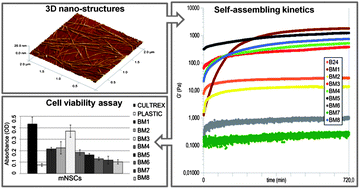Synthesis and characterization of designed BMHP1-derived self-assembling peptides for tissue engineering applications†
Abstract
The importance of self-assembling peptides (SAPs) in regenerative medicine is becoming increasingly recognized. The propensity of SAPs to form nanostructured fibers is governed by multiple forces including hydrogen bonds, hydrophobic interactions and π–π aromatic interactions among side chains of the amino acids. Single residue modifications in SAP sequences can significantly affect these forces. BMHP1-derived SAPs is a class of biotinylated oligopeptides, which self-assemble in β-structured fibers to form a self-healing hydrogel. In the current study, selected modifications in previously described BMHP1-derived SAPs were designed in order to investigate the influence of modified residues on self-assembly kinetics and scaffold formation properties. The Fourier transform infrared spectroscopy (FTIR) and X-ray diffraction (XRD) analysis demonstrated the secondary structure (β-sheet) formation in all modified SAP sequences, whereas atomic force microscopy (AFM) analysis further confirmed the presence of nanofibers. Furthermore, the fiber shape and dimension analysis by AFM showed flattened and twisted fiber morphology ranging from ∼8 nm to ∼70 nm. The mechanical properties of the pre-assembled and post assembled solution were investigated by rheometry. The shear-thinning behavior and rapid re-healing properties of the pre-assembled solutions make them a preferable choice for injectable scaffolds. The wide range of stiffnesses (G′) –from ∼1000 to ∼27 000 Pa – exhibited by the post-assembled scaffolds demonstrated their potential for a variety of tissue engineering applications. The extra cellular matrix (ECM) mimicking (physically and chemically) properties of SAP scaffolds enhanced cell adhesion and proliferation. The capability of the scaffold to facilitate murine neural stem cell (mNSC) proliferation was evaluated in vitro: the increased mNSCs adhesion and proliferation demonstrated the potential of newly synthesized SAPs for regenerative medicine approaches.


 Please wait while we load your content...
Please wait while we load your content...